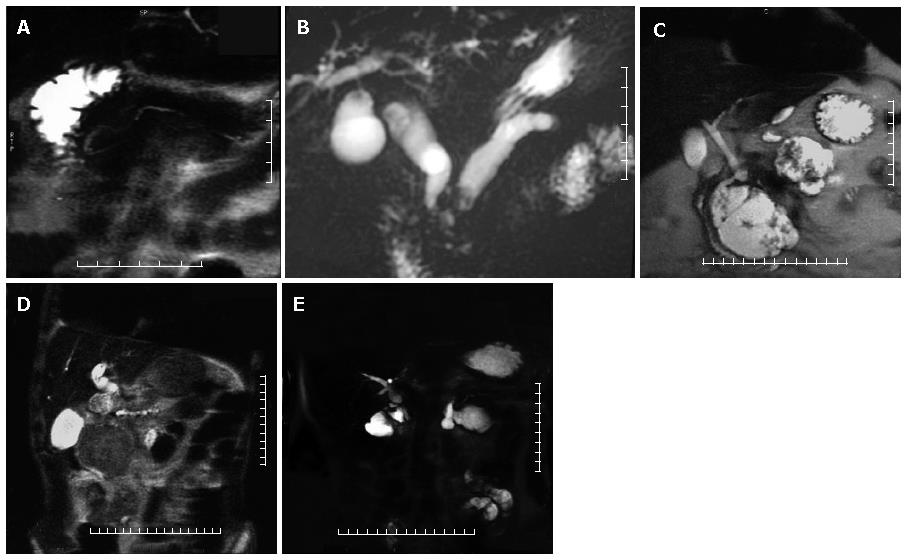Copyright
©2007 Baishideng Publishing Group Inc.
World J Gastroenterol. May 14, 2007; 13(18): 2529-2534
Published online May 14, 2007. doi: 10.3748/wjg.v13.i18.2529
Published online May 14, 2007. doi: 10.3748/wjg.v13.i18.2529
Figure 1 A: Coronal FSE thin section source image, numerous hypointense calculi are seen filling the gall -bladder.
There is also a small hypointense calcule located at the distal CBD; B: Coronal FSE thin section source image, an approximately 3 cm long segment stricture along the distal CBD is seen in a patient with history of blunt abdominal trauma; C: Axial FSE thin section source image, multifocal strictures and dilatations of the intrahepatic biliary ducts causing a beaded appearance in a patient with sclerosing cholangitis.
Figure 2 A: Coronal MIP image, a hypointense solid mass involving both the left and right main hepatic ducts representing Klatskin tumor is seen.
There is also proximal dilatation of the bile ducts before the mass; B: Coronal MIP image, a dorsal pancreatic duct is seen coursing the CBD and draining into the minor papilla. A smaller ventral pancreatic duct is draining into the major papilla together with the CBD; C: Coronal MIP image, clearly depicts the "double duct sign"; D: Coronal MIP image, a small periampullary carcinoma leading to mild dilatation of both CBD and pancreatic duct.
Figure 3 A: Coronal SSFSE thin section source image, the same duct abnormalities is clearly seen in a different patient with pancreas divisum; B: Coronal SSFSE thin section source image, CBD and pancreatic duct showing conspicuous dilatation in a chronic pancreatitis patient; C: Coronal FSE thin section source image, large pseudocyst formations are seen throughout the pancreas obscuring the CBD and pancreatic duct; D: Coronal FSE thin section source image, a large heterogeneous high signal intensity pancreatic head adenocarcinoma causing dilatation of both CBD and pancreatic duct is seen; E: Coronal MIP image, there is moderate dilatation and following abrupt but smooth tapering of CBD draining into the jejunum (choledochojejunostomy), also a small dilated cystic duct is seen.
Remnant pancreatic duct in the tail draining into the afferent jejunal loop (pancreaticojejunostomy). The patient had a history of whipple operation for pancreatic head adenocarcinoma.
- Citation: Halefoglu AM. Magnetic resonance cholangiopancreatography: A useful tool in the evaluation of pancreatic and biliary disorders. World J Gastroenterol 2007; 13(18): 2529-2534
- URL: https://www.wjgnet.com/1007-9327/full/v13/i18/2529.htm
- DOI: https://dx.doi.org/10.3748/wjg.v13.i18.2529















